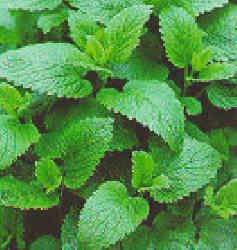

Balm (Melissa officinalis)
Folk Names: Balm Melissa, Balm Mint, Bee Balm, Blue Balm, Citronele, Cure-all, Dropsy Plant, Garden Balm, Honey Plant, Lemon Balsam, Lemon Balm, Melissa, Oswego Tea, Sweet Balm, Sweet Melissa
Description: Balm is a perennial mint common to the Mediterranean, the Near East, and in the US, it grows in New England west to Ohio and Kansas, and south to Arkansas and Florida. Because the root is perennial, the plant will die down in winter but start back up in the spring. It may be propagated by seeds, cuttings, or root division in spring or autumn. Balm prefers a sunny location with rich, sandy-loamy soil. The upright stem is hairy and quadrangular. In ideal surroundings, it is branched and grows up to three feet high, while the root is comparatively short. The light green leaves are opposite, ovate, long-petioled, and somewhat hairy. The edges are bluntly serrate and acuminate at each joint, Bilabiate flowers grow in axillary clusters, and may be white or pale yellow to rose or blue-white. The plant flowers from July to September. The entire plant has an aromatic, lemony scent and flavor.
Effects: gentle
Planet: Moon, Jupiter, Venus Zodiac Cancer
Element: water
Associated Deities: Diana
Traditions:
A popular belief is that Balm was a favorite in the temples of Diana. If Diana is one of your patron deities, or you wish to make her an offering, balm would be a good gift.
Magic:
While many ancient writers suggested balm be steeped in wine for the bite of a snake or rabid animals, and the sodden leaves applied as a poultice to the wound, soaking in wine is also suggested as a friendship spell. Soak the balm in wine for several hours, strain, and share with your friend to cement your relationship. It may also be rubbed on beehives to keep bees and attract more as it is a favorite with them.
Carry balm for true love, place it in sachets and pillows, or add it to your bath. It is a good additive to healing incense and sachets, especially for mental and nervous disorders, but also for any physical wounds as well. It was said to seal any “green,” ie new, wounds, and remove any possibility of infection. It is also said to keep mental processes sharp. The eleventh century Arabic physician Avicenna suggested balm could be used to “make merry” or improve your emotional disposition. Any spell for success would also benefit from the addition of sweet balm.
Known Combinations:
none noted
Medical Indications: Parts Used: herb, leaves
Carmelite water, an old remedy for neuralgia and headache, contains Nutmeg, Angelica root, Lemon zest, spirit of Balm (ie an alcohol extract), and Honey. Paracelsis felt balm had the ability to completely revive a person, and it was at one time used for all complaints pertaining to the nervous system. It is still suggested as a tea for menstrual cramps, nervous problems, panic attacks, hysteria, melancholy, insomnia, dyspepsia, flatulence, colic, chronic bronchial catarrh, some forms of asthma, and toothache. It is one of the few safe herbs for use during pregnancy, and may be taken for headaches, dizziness, and to reduce fever.
Due to its strong antiviral and antibacterial effects, it has been suggested as a treatment for cold sores. Balm is good as a poultice for sores, tumors, milk-knots, and insect bites. It may be used I cleansing lotions and infusions for relaxing baths.
Nutrition:
Balm, or lemon balm as it is called in many areas, may be used as a substitite for lemon in many recipes. In fact, it is used as a seasoning mainly for its lemon flavor and aroma. It can be found in fruit or vegetable salads, drinks, sauces, eggs, chicken, fish, lemonade, and soups.
Mercantile Uses:
Balm is well liked by bees, and its name, Melissa, comes from the Greek word for bee. The honey from balm is superior. The leaves are found in potpourris for their scent.